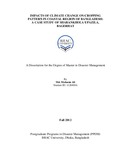| dc.contributor.advisor | Rahman, M Aminur | |
| dc.contributor.author | Ali, Md. Mohosin | |
| dc.date.accessioned | 2013-07-22T04:46:20Z | |
| dc.date.available | 2013-07-22T04:46:20Z | |
| dc.date.copyright | 2012 | |
| dc.date.issued | 2012 | |
| dc.identifier.other | ID 11268016 | |
| dc.identifier.uri | http://hdl.handle.net/10361/2723 | |
| dc.description | This dissertation is submitted in partial fulfillment of the requirements for the degree of Master in Disaster Management, 2012. | en_US |
| dc.description | Cataloged from PDF version of Dissertation. | |
| dc.description | Includes bibliographical references (page 68- 70). | |
| dc.description.abstract | Natural disaster occurs almost every year in Bangladesh due to climate change. Crop
agriculture is often constrained by different hazards and disasters such as floods,
droughts, soil and water salinity, cyclones and storm surges (MoEF 2009b). It is very
common phenomenon in coastal regions of this country. Southwestern part (Khulna
region) of Bangladesh is one of the worst affected regions facing the early impacts of
climate change particularly in agricultural and socio-economic sector. Every year it
causes extensive damages to the agriculture sector in Sharankhola Upazila and change
cropping pattern day by day. The Farmers of Sharankhola face a lot of problems to bring
all of their arable land under crops cultivation, especially, during winter Boro crops
season a lion portion of their land remain untilled only due to salinity problem, and
unavailability of quality seeds and agricultural equipments. The dominant crop grown in
the saline areas is local transplanted Aman rice crop with low yields. The cropping
patterns followed in the coastal areas are mainly Fallow-Fallow-Transplanted Aman rice.
The crop yield is negatively impacted by rise in temperature, erratic rainfall, flooding,
salinity, etc. and among which water logging and drainage congestion are the major
problems. The ecological conditions are more vulnerable which is very likely to be
alerted though slowly but surely due to climate change and sea level rise. Salinity causes
unfavorable environment and hydrological situation that restrict the normal crop
production throughout the year. The factors which contribute significantly to the
development of saline soil are, tidal flooding during wet season (June-October), direct
inundation by saline water, and upward or lateral movement of saline ground water
during dry season (November-May). Dependency on fertilizer and irrigation is increasing
which leads to permanent fertility loss of the land, loss of biodiversity, extinction of local
verities, ground water scarcity, loss the sustainability of production. However,
adaptations to climate change like agronomic manipulations, sustainable climate-resilient
agriculture, shifting the planting dates, using short duration crop cultivars can reduce
vulnerabilities, delay the process and increase food security. | en_US |
| dc.description.statementofresponsibility | Md. Mohosin Ali | |
| dc.format.extent | 81 pages | |
| dc.language.iso | en | en_US |
| dc.publisher | BRAC University | en_US |
| dc.rights | BRAC University dissertation are protected by copyright. They may be viewed from this source for any purpose, but reproduction or distribution in any format is prohibited without written permission. | |
| dc.subject | Disaster management | |
| dc.subject | Climate change | |
| dc.subject | Cropping | |
| dc.subject | Coastal region | |
| dc.title | Impacts of climate change on cropping pattern in coastal region of Bangladesh : a case study of Sharankhola Upazila , Bagerhat | en_US |
| dc.type | Dissertation | en_US |
| dc.contributor.department | Department of Architecture, BRAC University | |
| dc.description.degree | M. Disaster Management | |

